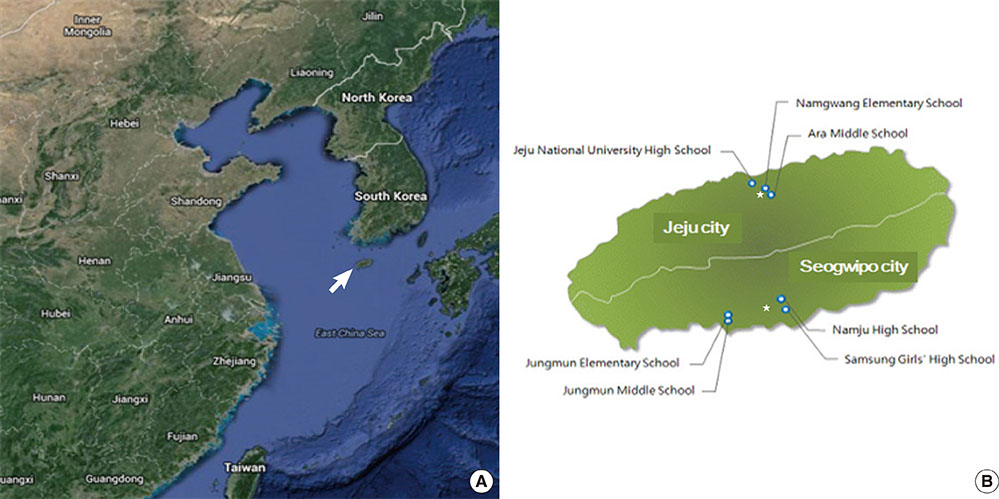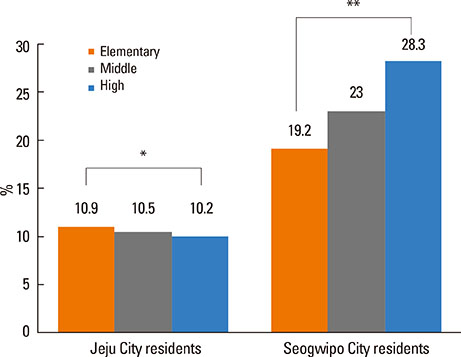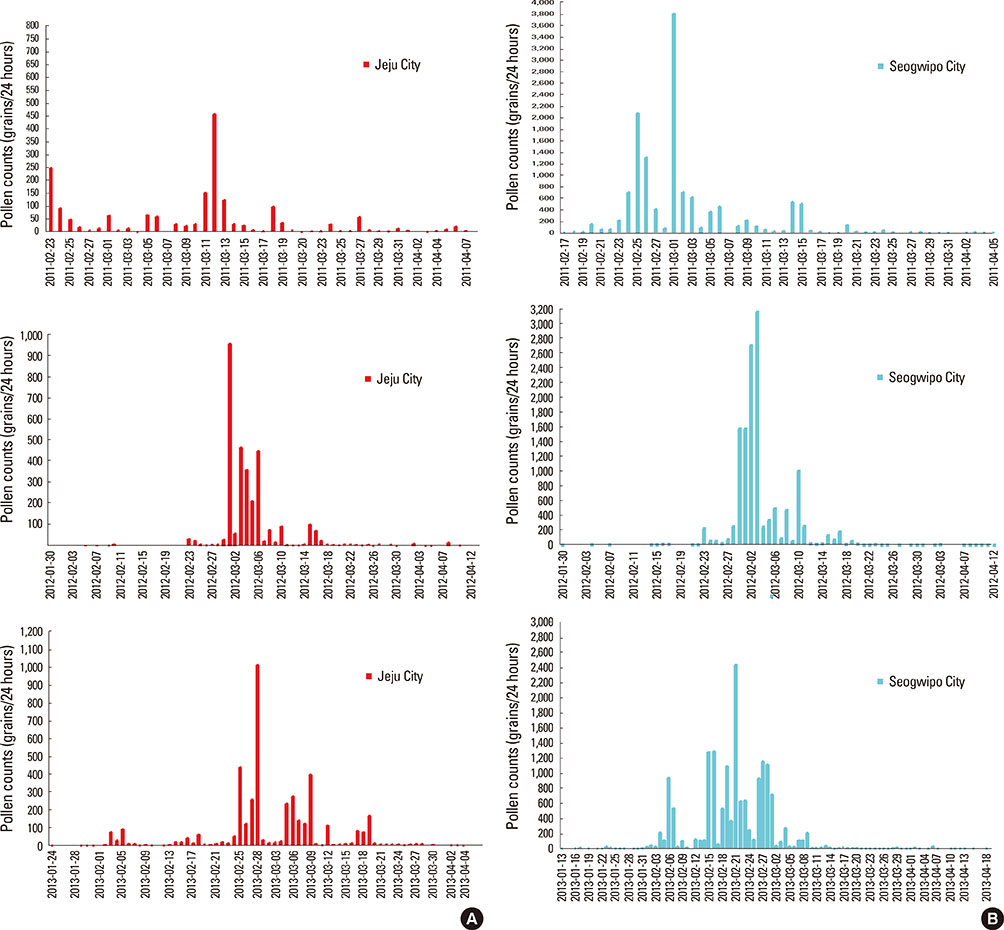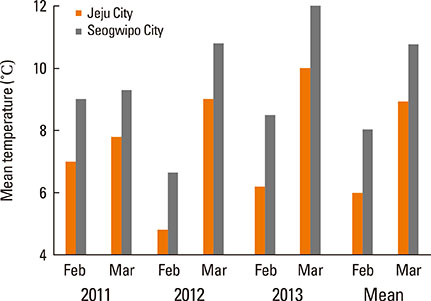Japanese Cedar (Cryptomeria japonica) Pollinosis in Jeju, Korea: Is It Increasing?
- Affiliations
-
- 1Department of Internal Medicine, Jeju National University School of Medicine, Jeju, Korea.
- 2Department of Microbiology, Jeju National University School of Medicine, Jeju, Korea. yomust7@jejunu.ac.kr
- 3Department of Preventive Medicine, Jeju National University School of Medicine, Jeju, Korea.
- 4Department of Otorhinolaryngology, Jeju National University School of Medicine, Jeju, Korea.
- 5The Environmental Health Center (Atopic dermatitis & Allergic rhinitis), Jeju National University School of Medicine, Jeju, Korea.
- KMID: 2260468
- DOI: http://doi.org/10.4168/aair.2015.7.3.295
Abstract
- Jeju is an island in South Korea located in a temperate climate zone. The Japanese cedar tree (JC) has become the dominant tree species while used widely to provide a windbreak for the tangerine orchard industry. An increase in pollen counts precedes atopic sensitization to pollen and pollinosis, but JC pollinosis in Jeju has never been studied. We investigated JC pollen counts, sensitization to JC pollen, and JC pollinosis. Participants were recruited among schoolchildren residing in Jeju City, the northern region (NR) and Seogwipo City, the southern region (SR) of the island. The JC pollen counts were monitored. Sensitization rates to common aeroallergens were evaluated by skin prick tests. Symptoms of pollinosis were surveyed. Among 1,225 schoolchildren (49.6% boys, median age 13 years), 566 (46.2%) were atopic. The rate of sensitization to Dermatophagoides pteronyssinus (35.8%) was highest, followed by D. farinae (26.2%), and JC pollen (17.6%). In the SR, 156 children (23.8%) were sensitized to JC pollen; this rate was significantly higher than that in the NR (59 children, 10.4%, P<0.001). A significant increment in the sensitization rate for JC pollen with increasing school level was observed only in the SR. JC pollen season in the SR started earlier and lasted longer than that in the NR. JC pollen season in Jeju was defined as extending from late January to mid-April. The prevalence of JC pollinosis was estimated to be 8.5%. The prevalence differed significantly between the NR and SR (5.3% vs 11.3%, P<0.001), mainly due to the difference in sensitization rates. JC pollen is the major outdoor allergen for early spring pollinosis in Jeju. JC pollen season is from late January to mid-April. Warmer weather during the flowering season scatters more JC pollen in the atmosphere, resulting in a higher sensitization rate in atopic individuals and, consequently, making JC pollinosis more prevalent.
Keyword
MeSH Terms
Figure
Cited by 2 articles
-
Unmet Primary Physicians' Needs for Allergic Rhinitis Care in Korea
Hyeon-Jong Yang, Young Hyo Kim, Bora Lee, Do Youn Kong, Dong-Kyu Kim, Mi-Ae Kim, Bong-Seong Kim, Won-young Kim, Jeong Hee Kim, Yang Park, So Yeon Park, Woo Yong Bae, Keejae Song, Min Suk Yang, Sang Min Lee, Young-Mok Lee, Hyun Jong Lee, Jae-Hong Cho, Hye Mi Jee, Jeong-Hee Choi, Young Yoo, Young-Il Koh,
Allergy Asthma Immunol Res. 2017;9(3):265-271. doi: 10.4168/aair.2017.9.3.265.Patterns of Inhalant Allergen Sensitization and Geographical Variation in Korean Adults: A Multicenter Retrospective Study
Min-Gyu Kang, Mi-Yeong Kim, Woo-Jung Song, Sujeong Kim, Eun-Jung Jo, Seung-Eun Lee, Jae-Woo Kwon, Sang-Min Lee, Chan-Sun Park, Hye-Kyung Park, Heung-Woo Park, Yoon-Seok Chang, Jaechun Lee, Young-Min Lee, Young-Koo Jee, Jong-Myung Lee, Inseon S. Choi, Sang-Heon Cho
Allergy Asthma Immunol Res. 2017;9(6):499-508. doi: 10.4168/aair.2017.9.6.499.
Reference
-
1. Jeju Special Self-Governing Province (KR). [Internet]. Jeju: Jeju Special Self-governing Province;2007. cited 2014 Dec 1. Available from: http://english.jeju.go.kr/.2. Oh JW, Lee HB, Kang IJ, Kim SW, Park KS, Kook MH, et al. The revised edition of Korean calendar for allergenic pollens. Allergy Asthma Immunol Res. 2012; 4:5–11.3. Jeon BH, Lee J, Kim JH, Kim JW, Lee HS, Lee KH. Atopy and sensitization rates to aeroallergens in children and teenagers in Jeju, Korea. Korean J Asthma Allergy Clin Immunol. 2010; 30:14–20.4. Kim TB, Kim KM, Kim SH, Kang HR, Chang YS, Kim CW, et al. Sensitization rates for inhalant allergens in Korea; a multi-center study. J Asthma Allergy Clin Immunol. 2003; 23:483–493.5. Korea Meteorological Administration. [Internet]. Seoul: Korea Meteorological Administration;2013. cited 2014 Dec 1. Available from: http://www.kma.go.kr/.6. Lee HS, Hong SC, Kim SY, Lee KH, Kim JW, Kim JH, et al. The Influence of the residential environment on the sensitization rates to aeroallergens and the prevalence of allergic disorders in the school children in Jeju. Pediatr Allergy Respir Dis. 2011; 21:176–185.7. Honda K, Saito H, Fukui N, Ito E, Ishikawa K. The relationship between pollen count levels and prevalence of Japanese cedar pollinosis in Northeast Japan. Allergol Int. 2013; 62:375–380.8. Kanazawa A, Terada T, Ozasa K, Hyo S, Araki N, Kawata R, et al. Continuous 6-year follow-up study of sensitization to Japanese cedar pollen and onset in schoolchildren. Allergol Int. 2014; 63:95–101.9. Okamoto Y, Horiguchi S, Yamamoto H, Yonekura S, Hanazawa T. Present situation of cedar pollinosis in Japan and its immune responses. Allergol Int. 2009; 58:155–162.10. Ozasa K, Hama T, Dejima K, Watanabe Y, Hyo S, Terada T, et al. A 13-year study of Japanese cedar pollinosis in Japanese schoolchildren. Allergol Int. 2008; 57:175–180.11. Kaneko Y, Motohashi Y, Nakamura H, Endo T, Eboshida A. Increasing prevalence of Japanese cedar pollinosis: a meta-regression analysis. Int Arch Allergy Immunol. 2005; 136:365–371.12. Min KU, Kim YK, Jang YS, Jung JW, Bahn JW, Lee BJ, et al. Prevalence of allergic rhinitis and its causative allergens in people in rural area of Cheju island. J Asthma Allergy Clin Immunol. 1999; 19:42–49.13. Yamada T, Saito H, Fujieda S. Present state of Japanese cedar pollinosis: the national affliction. J Allergy Clin Immunol. 2014; 133:632–639.14. Interagency Working Group on Climate Change and Health. A human health perspective on climate change: a report outlining the research needs on the human health effects of climate change. Research Triangle Park, NC: Environmental Health Perspectives/National Institute of Environmental Health Sciences;2010.15. Stitt M. Rising CO2 levels and their potential significance for carbon flow in photosynthetic cells. Plant Cell Environ. 1991; 14:741–762.16. Beggs PJ. Impacts of climate change on aeroallergens: past and future. Clin Exp Allergy. 2004; 34:1507–1513.17. van Vliet AJ, Overeem A, De Groot RS, Jacobs AF, Spieksma FT. The influence of temperature and climate change on the timing of pollen release in the Netherlands. Int J Climatol. 2002; 22:1757–1767.18. Teranishi H, Katoh T, Kenda K, Hayashi S. Global warming and the earlier start of the Japanese-cedar (Cryptomeria japonica) pollen season in Toyama, Japan. Aerobiologia. 2006; 22:90–94.19. Lee SH, Nam KW, Jeong JY, Yoo SJ, Koh YS, Lee S, et al. The effects of climate change and globalization on mosquito vectors: evidence from Jeju island, South Korea on the potential for Asian tiger mosquito (Aedes albopictus) influxes and survival from Vietnam rather than Japan. PLoS One. 2013; 8:e68512.
- Full Text Links
- Actions
-
Cited
- CITED
-
- Close
- Share
- Similar articles
-
- Atopy and Sensitization Rates to Aeroallergens in Children and Teenagers in Jeju, Korea
- Allergic Diseases by Pollens (Pollinosis)
- Allergic Rhinitis to Japanese Cedar in Cheju Island
- Sublingual Immunotherapy for Japanese Cedar Pollinosis Attenuates Asthma Exacerbation
- The Influence of the Residential Environment on the Sensitization Rates to Aeroallergens and the Prevalence of Allergic Disorders in the School Children in Jeju





